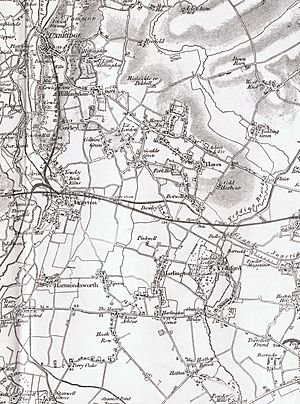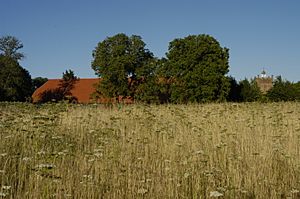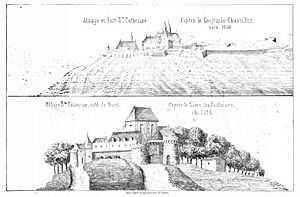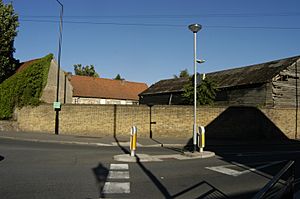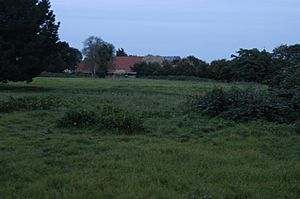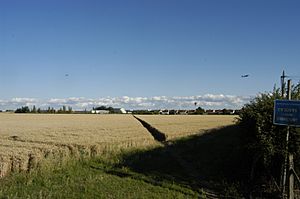Harmondsworth facts for kids
Quick facts for kids Harmondsworth |
|
|---|---|
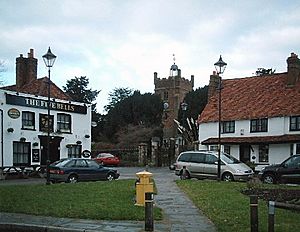 Harmondsworth Village |
|
| Population | 1,478 – 2011 census |
| OS grid reference | TQ055775 |
| • Charing Cross | 15 mi (24 km) E by NE |
| London borough | |
| Ceremonial county | Greater London |
| Region | |
| Country | England |
| Sovereign state | United Kingdom |
| Post town | WEST DRAYTON |
| Postcode district | UB7 |
| Dialling code | 020 |
| Police | Metropolitan |
| Fire | London |
| Ambulance | London |
| EU Parliament | London |
| UK Parliament |
|
| London Assembly |
|
Harmondsworth is a village located in the London Borough of Hillingdon in Greater London. It's very close to London Heathrow Airport and the border of Berkshire county. The village doesn't have its own train station, but it's right next to the M4 motorway and the A4 road (also known as the Bath Road).
Harmondsworth used to be part of the historic county of Middlesex until 1965. It's an old parish that once included larger areas like Heathrow, Longford, and Sipson. Today, Longford and Sipson are seen as separate villages, but they still rely on Harmondsworth for some things, like schools.
Two important medieval buildings in the village are the Great Barn and the parish church. A lot of the land in Harmondsworth is used for things related to air travel and hotels. The village also has public parks with walking paths and is near the River Colne. This area is part of the Colne Valley Regional Park, which is rich in nature.
The western part of the parish is home to the main offices of two major airlines. It also has two places where people who don't have permission to stay in the UK are held. Many international visitors stay in hotels here, even though these hotels are often called "Heathrow" hotels because they are so close to the airport.
In 2016, the government announced plans for a third runway at Heathrow Airport. If these plans go ahead, about half of Harmondsworth village would need to be removed to make space for the new runway. The other half, including the historic church and Great Barn, would be very close to the airport's edge.
Contents
A Look at Harmondsworth's Past

Harmondsworth is mentioned in the famous Domesday Book, which was a survey of England completed in 1086. Its name comes from old Anglo-Saxon words, meaning "Heremōd's enclosure" or "Heremund's enclosure."
The name of Harmondsworth was first written down in AD 780. This was when King Offa gave land here to his helper, Aeldred.
Before 1066, the land was owned by Harold Godwinson, who later became King Harold. After the Norman Conquest in 1066, King William I took ownership. In 1069, King William gave the land to a Benedictine Abbey in Rouen, France. This abbey owned Harmondsworth until 1391.
In 1391, William of Wykeham, who was the Bishop of Winchester, bought the manor of Harmondsworth. He used this land to help fund his two colleges: Winchester College and New College, Oxford. These colleges kept the manor until 1543, when they gave it to King Henry VIII in exchange for other land.
In 1547, King Henry VIII gave the lordship and manor to William Paget, 1st Baron Paget. The Paget family owned the manor for many years, selling parts of it over time.
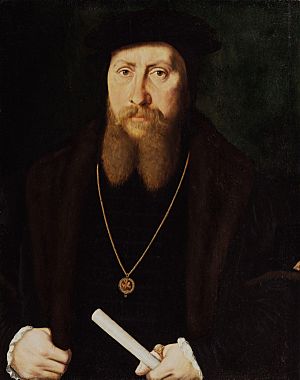
Harmondsworth was once a farming area. But in 1929, things started to change when the Colnbrook by-pass road opened. This road helped connect the area better.
Industrial growth began in 1930 with the opening of the Road Research Laboratory on this new road. In the same year, the Fairey Aviation Company opened an airfield (a small airport) nearby. This airfield later became the start of what we know today as Heathrow Airport.
By the late 1930s, some houses were built, mostly in the northern part of the parish. Gravel, sand, and grit were also dug from the land. In 1944, the Fairey airfield was taken over by the Royal Air Force and became Heathrow R.A.F. station. This led to the removal of the small villages of Heathrow and Perry Oaks.
From 1937, the famous Penguin Books company had its offices and warehouses in Harmondsworth. Many of their books published in the UK would say "Harmondsworth, Middlesex" as their publishing location. Penguin Books gradually closed its operations here in the 1990s.
In 1965, Harmondsworth became part of the London Borough of Hillingdon in the new area called Greater London.
The Village Church
The old parish church in Harmondsworth is called the Church of St Mary. Some parts of this church are very old, dating back to the 12th century. It is believed that Heathrow Airport might be legally responsible for looking after the church's chancel (the part of the church near the altar). This is because the airport now owns land that was once used to help pay for the chancel's upkeep.
The Great Barn
Another very important old building in Harmondsworth is the Harmondsworth Great Barn. It is Britain's largest barn and is considered a Grade I-listed building, meaning it's very important historically. It was built between 1425 and 1427 on land bought by William of Wykeham, the Bishop of Winchester. He bought the land to support his colleges, Winchester College and New College, Oxford.
The Great Barn is the largest timber-framed building still standing in England. The English poet John Betjeman even called it the "Cathedral of Middlesex" because of its impressive size. Since January 2012, English Heritage owns the barn.
There's a similar barn at Old Burghclere, Hampshire, built about 25 years later. It's shorter than the Harmondsworth barn but also very large and impressive.
Cottage Hospital
The Harlington, Harmondsworth and Cranford Cottage Hospital was set up in 1884 and opened in 1885. It was located on Sipson Road, between Harmondsworth and Cranford.
Local Economy

British Airways, a major airline, has its main office called Waterside in Harmondsworth. This building officially opened in 1998. An office for American Airlines is also located here.
Harmondsworth village has two traditional pubs: The Crown and the Five Bells.
As mentioned, the village was also home to Penguin Books from 1937 until the 1990s.
Education
Harmondsworth Primary School is the local school in Harmondsworth.
Getting Around
The area is served by various bus routes. The nearest train station is West Drayton railway station, about 2 miles north, across the M4 motorway. The A4 road (Bath Road) goes through the village, and there are junctions in nearby villages that connect to the M4 motorway.
Population Details
The population of Harmondsworth changes quite a bit. This is because it includes not just homes, but also hotels and the two immigration centers. So, the number of people living or staying there can go up and down.
| Part | Population on date of census | Area in km2 |
|---|---|---|
| Centre and east | 354 | 0.124 |
| North | 341 | 0.012 |
| West | 319 | 0.021 |
| South: includes 25% of Heathrow Airport | 464 | 0.422 |
| Total | 1478 | 0.589 |
People Connected to Harmondsworth
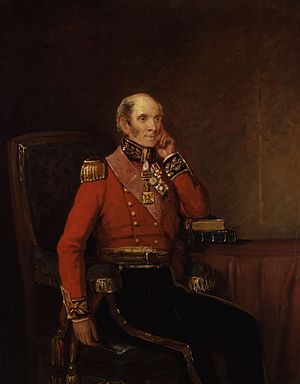
Many interesting people have been connected to Harmondsworth throughout history:
- Offa of Mercia (died 796 AD): A powerful Anglo-Saxon king who granted land in Harmondsworth in 780 AD.
- Harold Godwinson (died 1066): The last Anglo-Saxon king of England, who owned the manor of Harmondsworth before the Norman Conquest.
- William the Conqueror (died 1087): The first Norman King of England, who took ownership of Harmondsworth after the Conquest.
- William of Wykeham (1320 or 1324–1404): A Bishop of Winchester and Chancellor of England. He bought Harmondsworth in 1391 to support his colleges.
- William Paget, 1st Baron Paget (1506–1563): A Lord Privy Seal, who was granted the lordship and manor of Harmondsworth in 1547.
- Richard Cox (c.1766–1845): A famous gardener who bred the "Cox's Orange Pippin" apple.
- Sir Charles Richard Fairey (1887–1956): He founded the Fairey Aviation Company and started the airfield at Heathrow in 1930.
- Sir John Betjeman (1906–1984): A well-known English poet who called the Harmondsworth Great Barn the "Cathedral of Middlesex."
Important Buildings in Harmondsworth
| name | type | built | occupant | demolished? | use of house or site now |
|---|---|---|---|---|---|
| Harmondsworth Great Barn | barn | early 15th century | no | ||
| Manor Farm | farmhouse | early 19th century | no | farm until the early 1970s, then offices | |
| Harmondsworth Hall | house | early 18th century | no | home and hotel | |
| The Grange | house | from 1675 | no | offices | |
| The Lodge | house | early 19th century | no | domestic until the early 1960s, then offices |
Nearby Places
 |
across part of Iver Langley |
West Drayton | West Drayton |  |
| Colnbrook | Sipson | |||
| Stanwell Moor | across Heathrow Airport Stanwell |
across Heathrow Airport Bedfont |
|
See also
 In Spanish: Harmondsworth para niños
In Spanish: Harmondsworth para niños



